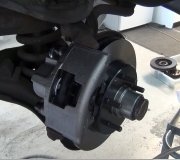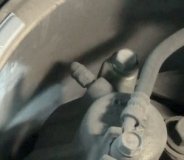A number of things came to mind. First, replacing just the piston is the worst way to go with this design. It has to be filled with brake fluid before it is installed, otherwise the air will never come out. Second, it is only replaced if the chrome plating has lifted and there's rust forming under it. Otherwise, it's the square-cut seal that leaks and must be replaced. Those come in a kit with one seal and one dust boot for one caliper rebuild.
The point of value is with this design, the pistons do not self-adjust by just pumping the brake pedal, like the front ones do. These are adjusted by applying the parking brake a few times. It's common on Ford products to find the parking brake cables rusted tight after a couple of years. In that case, you can use a large Channel Lock pliers to work the parking brake lever on the caliper by hand. Once adjusted out, the caliper will self-adjust for normal pad wear like normal on most models. On some, they only adjust when using the parking brake regularly. Until that caliper is adjusted, the brake pedal will be real low. The master cylinder's piston for one front brake and the opposite rear brake has to push brake fluid to those wheels, and it pushes fluid that pushes on the piston that moves fluid to the other two wheels. That required volume goes way up when a rear caliper isn't adjusted.
Next, the loading of minivans and pickup trucks can vary a lot. To address that and maintain balanced braking front-to-rear, most use a height-sensing proportioning valve at the rear axle. If the vehicle is supported on jack stands or on a hoist with the rear axle hanging down, it will look to that valve as though the rear is lightly-loaded, and less brake fluid pressure must go to the rear, to prevent rear-wheel lock-up. It is often necessary to set the vehicle down on the tires to open up the proportioning valve and get fluid flowing faster.
One of the things we see too often is after pedal-bleeding with a helper, the master cylinder is damaged or crud is pushed down one of the steel lines. By about a year, crud and corrosion build up in the lower halves of the bores where the pistons don't normally travel in the master cylinder. It's important when pedal-bleeding to never push the brake pedal more than half way to the floor to avoid running the rubber lip seals over that crud, and ripping them. Ford products often have four steel lines leaving the master cylinder instead of just two, so it is possible to have a problem with just one brake.
SPONSORED LINKS
Thursday, April 4th, 2019 AT 9:21 PM




